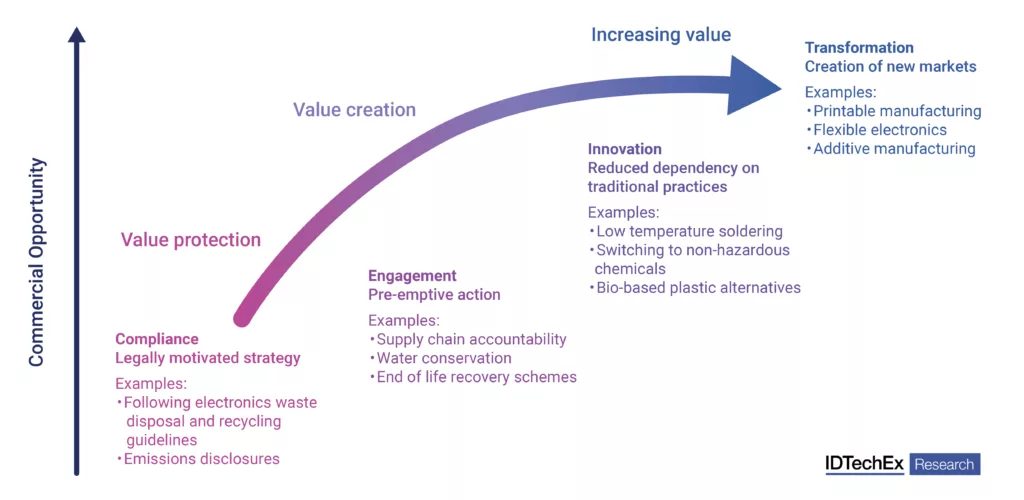IDTechEx’s report Sustainable Electronics Manufacturing 2023-2033 discusses the commercial opportunities presented by sustainable innovation
Enhancing sustainability is a widely held aspiration within the electronics industry but realising this transition is considerably more difficult. To this day, toxic chemicals, material waste and energy-intensive processing are commonplace. While many companies have demonstrated a clear interest in lowering their environmental impact, making changes while meeting the growing demand for increasingly sophisticated electronics is extremely challenging. Every year, vehicles, households, retailers and factories become smarter with the increased prevalence of IoT devices—a market expected to reach billions over the coming decade. Despite the many advantages of smartification, the environmental footprint is high, with the number of devices increasing exponentially.
Is it possible to keep the wheel of innovation turning while being environmentally conscientious? The answer is yes. IDTechEx’s report Sustainable Electronics Manufacturing 2023-2033, explores the key opportunities for sustainable innovation and the most promising new manufacturing approaches within the electronics industry. It discusses various approaches that can be implemented to reduce the environmental impact associated with the manufacturing of printed circuit boards and integrated circuits. The report also clarifies how various companies have achieved important milestones on their way to net zero and how emerging start-ups have developed impressive sustainable technologies that have the potential to transform the industry.
The newly founded Semiconductor Climate Consortium made itself known at the COP27 conference. The Consortium comprises 60 founding members, among whom are materials companies, research institutes and some of the biggest chip manufacturers, including Intel, Micron, TSMC and Samsung. Their ambition is to reduce greenhouse gas emissions across the supply chain with the collective target of reaching net zero by 2050.
By committing to net zero targets, manufacturers are forced to re-evaluate their processes and adopt new methods. For example, some are utilizing renewable energy sources to reduce their emissions contributions. As energy prices become more volatile and supply chain disruptions more frequent, renewable energy is becoming an increasingly attractive asset. Access to renewable energy is becoming a major factor as companies build new fabrication facilities. Samsung has already achieved 100 per cent renewable energy for all of its sites in the US and China, with other household name companies following suit, such as Apple, IBM, Intel and Nokia.
Water conservation is becoming an increasingly important discussion point, both from an environmental and economical perspective. It is estimated that 8,000 litres of water are consumed in the manufacturing of a single integrated circuit with a single fab using up to 15 million litres per day. Many fabs are located in water-stressed areas such as Singapore and Taiwan, as well as parts of the US and China. As droughts and climate disasters become more frequent and more drastic, water recovery and re-use is expected to de-risk the manufacturing process by supplementing the deficit. Additionally, being able to demonstrate high water conservation rates is excellent for improving public opinion and reputation. Among the household names, Intel and Samsung have shown strong commitment, conserving 70 and 60 per cent of the water they consumed, respectively. Enacting water conservation measures will lead to greater self-sufficiency and reduced costs.
Environmentalism is often perceived as an obstacle-laden with legislative red tape and burdensome disclosures. However, companies that embrace environmentalism reap long-term rewards and as such the negative perception is replaced by one of opportunity. The implementation of low-emission manufacturing processes or the adoption of material recycling and recovery schemes can be the financially astute choice presenting an opportunity to reduce costs associated with energy consumption, waste treatment and superfluous steps. Prioritizing environmentalism keeps the industry ahead of the curve as legislation becomes stricter while positioning individual companies well to benefit from designated ESG investment.
As energy prices rise globally, low temperatures and rapid processing methods become more attractive. Some of these methods employ additive approaches that substantially cut waste by printing material only where needed. This spares manufacturers the costs and emissions associated with excess materials and etching required in traditional subtractive manufacturing. For example, switching to printable or additive methods of PCB manufacturing can lower water consumption by up to 95 per cent—an outcome that could save the sector hundreds of millions of litres of water annually.
Component attachment materials, such as solder and electrically conductive adhesives, are also experiencing a period of transformation. New approaches are largely concentrated on reducing the required heat for reflow or curing. Employing lower-temperature processing will enable a wider range of materials that can be used, such as polymer substrates, organics and bio-based materials. It will also have the advantage of reducing manufacturing costs if energy consumption is reduced.
Reducing the carbon footprint of the electronics industry is a daunting task, particularly for well-established manufacturers that are reluctant to divert from traditional methods. Across the world, both government and consumer pressure are forcing manufacturers to take on a greater degree of responsibility in reducing their emissions. IDTechEx’s analysis indicates that by embracing sustainable manufacturing methods, companies can benefit economically while making significant reductions in environmental impact. A comprehensive analysis and exploration of sustainable innovations within the field can be found in IDTechEx’s report: Sustainable Electronics Manufacturing 2023-2033.
This report analyses the many innovations aiming to make electronics manufacturing more sustainable and how they are being deployed. It examines the current status and latest trends in technology performance, supply chain and manufacturing while exploring the influence of major environmental policies. It also identifies the key challenges, competition and innovation opportunities within sustainable electronics manufacturing.
www.idtechex.com/sustainableelectronics

